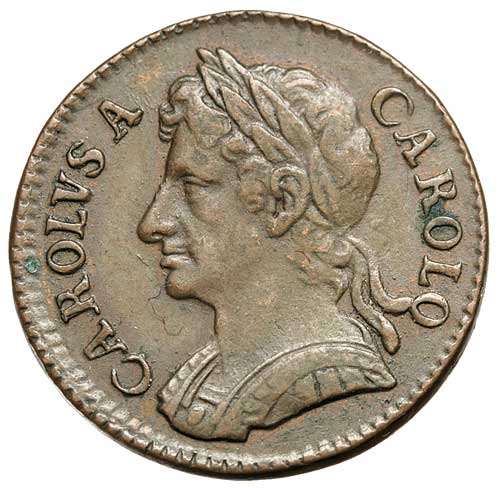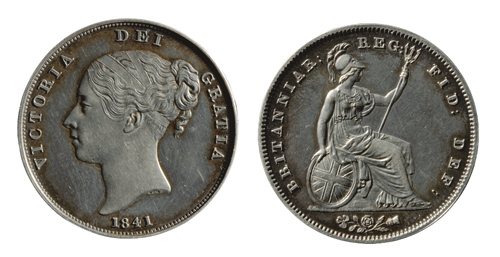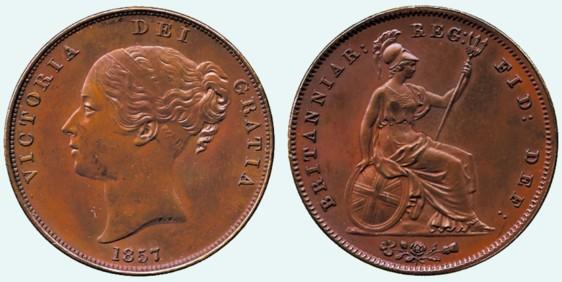|
|
The current range of books. Click the image above to see them on Amazon (printed and Kindle format). More info on coinpublications.com |
|
|


oldcopper
-
Content Count
611 -
Joined
-
Last visited
-
Days Won
15
Posts posted by oldcopper
-
-
On 10/22/2022 at 10:34 AM, TomGoodheart said:Gold doesn't tarnish. And gloves can make you clumsy. Dropping a coin like that is more risk than fingerprints to the edge that would clean if required.
Baldwin's did a video on exactly that point. They don't wear gloves for any metal, which with expensive copper personally I would say is a bit risky. Still, risk/benefit of more likelihood of dropping it I suppose.
-
7 minutes ago, Coinery said:Amazing the difference two photos can make! The first looks like it’s just popped off the die, the second, like it’s been on the bottom of the ocean a few hundred years!
The variable rim outside the border is a giveaway. Exactly the same in both.
-
 1
1
-
-
15 hours ago, Master Jmd said:This is a great discovery, thanks for sharing!
In terms of the farthings, are there any differences between the regular 1953 proof sets and the VIP sets (without this particular example) aside from provenance? I'm trying to put together a list of post-1900 farthings I need to be on the look out for and I'm not sure if the regular VIP set example is something I should include.
The farthing is described as "Freeman 1+A (not listed as a proof)". I think the George VI-type bordered penny was one of the main interests of this set. It went for £4200 hammer.
But to pay £6500 for a set in 2021 from DNW described as having a superior finish but without any rare varieties and having the normal case shape would seem to be a big leap of faith.
-
 1
1
-
 1
1
-
-

Here's a nice 1673 one ex Noble Numismatics auction 3 or 4 years ago. They didn't notice it either.
-
 1
1
-
 1
1
-
-
23 hours ago, copper123 said:I agree while the charles II series has been very popular over the last twenty years its mostly been the silver and gold, coppers have been left out in the cold a bit - the exception is high grade halfpence and good attractive farthings .
Unfortunately error and mistake coins have never really joined the party not sure why I surpose its because its always been a niche market . Ie everyone wants a high grade charles II as a type coin but few specialise in the more interesting errors
One reason could be that there have been hardly any 17th century mis-spellings in even half-decent condition (ie as good as they come) on the market in the last 15 years. I can't speak so much for farthings, or transactions via less high-profile dealers but to the best of my knowledge here are the last appearances for the best halfpenny ones:
1699 TERTVS - 2006 (Gregory I) Peck Plate Coin. Best known
1696 TERTVS - 2012 (Lockdales, ex Nicholson) Peck Plate Coin. Best known
1699 GVILELMVS - 2004 (Nicholson). Best known
1700 GVLIEEMVS - ~2007/8 (Baldwins). VF -GVF, better condition than the other mispellings listed here.
1699 GVLIEMVS - 2004 (Nicholson). Best known
The 1700 GVLIELMS variety generally turns up in similar condition but only ~ Fine or less - I've got one about 15 years ago not too inferior to the Peck Plate Coin for about £70.
1672 CRAOLVS - 2007 (DNW, not admitted as, but is the Peck Plate coin). Best known
1673 CRAOLVS - 2004 (Nicholson - perhaps not quite as good detail as the SNC 1994 one, but best sold since).
Peck's 1699 GVLIEMVS Plate coin sat around for years in the Baldwins trays after it didn't sell at one of their Gregory auctions - it was very ropey though!
Though I know much less about farthings, the 1697 GVLIELMS in lustrous, virtually mint state (DNW, 2010) though not struck up at the bottom of the bust or Brit's head due to an uneven flan) must be the finest known of all the 17th century copper mis-spellings, by a mile.
-
 2
2
-
-
-
20 hours ago, VickySilver said:Okay, I know the usual caveats of holding coin in hand and quality of photos, blah, blah, blah. HOWEVER (and I know I may be biased but have NO axe to grind), I wonder what readers think of at least three of the coins on sale:
- the two specimens of 1839 Halfcrown proof
- the 1893 crown proof
- the 1902 florin matte proof (in 67 no less)
I was completely flabbergasted and am not necessarily a conspiracy person, but I can't help but believe that these grades are inflated. Now whether that is due to the source of the consignor, I can't say - but certainly must wonder. There were numerous other examples that IMHO had "blown up" grades as well.
I must be a bit slow here but i can't find the 1839 halfcrowns in either Action 79 (British Collection part 3) or Auction 80/2 (the other British stuff).
-
Apparently the slabbers have only got 20 seconds to grade a coin these days, which is bound to lead to some flaws getting missed. As one coin man at a London auction house said, there's no way they can properly grade a coin in that timeframe.
-
The trouble is you don't see digs like that even on a common or garden example. Look at the cleft on his cheek as well:
And nose!
-
Interesting sale, some fantastic coins there. I was interested in what was one of the most detailed long hair ChII farthing patterns, though with some obverse digs (lot 110). But as often happens I found the one person in the world who wanted it more than me!
Those two ChII pattern shillings/farthings went astronomical. I might have had a flutter at 2-3K for the portrait one but 14K, that is a lot. Still, it's probably one of only two known, it's almost certainly the ESC plate coin in my edition, and the only other one known is the ropey and porous one in the BM (Illustrated in Peck). It probably doesn't belong to the copper series, but what a coin.
People often misacribe the more common "date between crowns" variety as ESC 1067A, when that is specifically the "date either side" variety. Because they can then call it "R6 in ESC" probably! Mark Rasmussen had probably the nicest one of those on the market in his copper collection of Lists 14-17 at £1500 - not lustrous but good detail. I'm surprised the variety is not in ESC, as it is an almost identical design to 1067A.
One surprise in the sale - the Churchill crown at MS66 - really? It fetched £320 but you can see obtrusive digs at the bottom of Churchill, and it looks dirty. I thought mine's better than that - value less than £5. Perhaps Richard's right about this slabbing business......
-
Talking of brass thrupennies, has anyone looked closely at the Ed VIII one coming up in Sovereign Rarities tomorrow?
I wonder if it's even made of brass. The colour is very yellowy, and compares exactly with the 1806 gilt penny a few lots later, but perhaps more importantly, and this is most apparent if anyone's got a printed catalogue (with the big blow-up of it on the front cover), there seems to be some localised peeling of the surface colour to reveal brown metal (ie copper) underneath, around the truncation and back of the hair. It may just be an optical illusion, but could this be a mint trial in copper subsequently covered with a yellow metal coating?
It's lightweight (~6g), but that doesn't neccesarily mean anything, as Peck lists even lighter and thus thinner-flan variants.
I should add i haven't seen it in the hand.
-
On 1/12/2022 at 9:37 PM, alfnail said:Didn't Dave also get robbed several years ago on his way back from a Midland Coin Fair?
Sorry, just replied that he did but didn't see the post above.
-
21 hours ago, Rob said:I bought this and wasn't wholely convinced it was a proof. A view shared by the person I sold it to as well. It was ex Peck and Norweb and has subsequently gone through another sale, but don't have the details.
It was sold by Colin Cooke in 2018 for ~£5K. Norweb did point out it had a silght edge knock which wasn't mentioned in the later sale. I have to say it looks rather dull from the photos.
-
However, you should see some of the 19th and early 20th century auction prices for iconic early copper patterns and proofs for instance. Here's one example:
Mackerell 1906:
Anne Vigo five guineas "brilliant" - £30
Anne Bello and Pace farthing (later the Brookes specimen, in worn condition, illustrated in Peck) - £40
-
 1
1
-
-
1 hour ago, 1949threepence said:Think what it would be worth now, quite apart from the cache of owning such a piece.
It was a beauty to behold as well, struck on a really thick flan in my Spink viewing.
-
21 minutes ago, 1949threepence said:Interesting reference. At page 126, under Victorian Pennies, Montagu says the following:-
I checked Peck to see if there were any 1857 Halfpenny, Farthing, half, third or quarter farthing copper proofs mentioned, just in case this was what Montagu meant, even though under pennies, but nothing. In fact for half, third and quarter farthing there was no currency strike for that year either.
In due deference to Montagu, he was around during this period (book was written in 1885), and therefore would have had the much greater knowledge afforded by proximity in real time. So maybe they do exist.
Montagu doesn't mention 1844 as a proof year, but it is alluded to by Peck as an excessively rare copper proof. We already know about 1841, 1853, 1856 and 1859. There was an 1856 PT proof penny in the Adams collection, but no 1844 and no 1857.
Anybody ever seen or heard of an extant 1844 proof penny?
Baldwins sold a possible 1844 "proof" penny which they said they didn't think was a proof, just a well struck currency, in the late 2000's. I don't think they exist, unless one turns up of course! Peck didn't see one and I think he was just going on an old reference in his footnote (again from memory, I don't have Peck to hand).
Adams also didn't have the 1841 copper and the 1853 bronzed proofs.
Now that Montagu mentioned the silver 1841 penny, that must be one of the biggest regrets of my (numismatic) life to miss out on it (I think it's the only one in commerce) when it came up in the Glenister Spink auction in 2007. Way out of my budget then, but if only I'd pushed the boat out - it went for £4,000.

-
 1
1
-
-
46 minutes ago, secret santa said:That'll do for me. Thanks Pete (I think it's Pete - we met at DNW a couple of years ago).
Sure did!
-
14 hours ago, secret santa said:Baldwins bought the Deane collection in the 1940's or early 50's from my memory of their catalogue descriptions, so chances are that Peck would have seen this coin. I don't know if the earlier Deane ticket called it a proof, but it would certainly have been brought to Peck's attention if it was thought a proof at the time. It was an obvious currency strike to me - of course there are sometimes grey areas as to whether or not a coin is a proof, but this one was clear enough even at a glance. Look at the scaling above the breast for instance on the blown up LC photo. I think it fetched about £600 at the Bladwins sale.
-
 1
1
-
-
21 hours ago, alfnail said:Just came across this sale, which I cross referenced in my collection yonks ago.
Can anyone shed light please, doesn't particularly look like a proof to me; is that what it's saying?
http://www.londoncoins.co.uk/?page=Pastresults&auc=124&searchlot=666&searchtype=2
I saw it at the Baldwins and the LC auctions - and no way is it a proof! That fact was underlined by LCs's description quoting Baldwins only and not saying anything about the coin themselves. It fetched only a fraction of what it got at the Baldwins sale.
-
I'm sure that link has examined those claims as well.......or is it all one-way traffic with some people. I wonder if Tony Heller ever made those claims? Or if any climate alarmists have ever taken trends out of context then simulated impending armageddon? Surely not!
-
 1
1
-
-
Fancy a cricket anyone?!
I don't know if anyone has been following what has been going on with the Dutch farmers and thier massive demonstrations. All despite the Netherlands being the second largest exporter of food in the world just behind the US. Some papers have carried small news reports on it. Done in the name of climate change of course, in this case ammonia emissions.
He mentions the absurdity of China's record and forecast re their CO2 emission amongst other things, to show that no one in power is seriously enacting this craziness to lower CO2. And the fact that it will just result in everyone from our energy-poor economies importing yet more from the massive carbon-emitting China. I think he has a point! Worth watching. OK, the interviewer has a cowboy hat on but I think we can forgive him that.
-
 1
1
-
-
19 hours ago, Nick said:Another interesting video from the US about the July 2022 weather statistics produced by NOAA. The most interesting bit starts about 7 minutes in.
It is difficult for people to overcome the psychological barrier that people in authority or their beloved media are lying to them by data manipulation or suppression. This has happened in other areas such as covid and the racial politics both in the US and here, in fact it seems that if the globalists decree something to be so, scientists and bureaucrats will find it so.
The ONS got criticism for misleading everyone about the vaccinated vs unvaccinated take up of ICU beds last year - a blatant manipulation to give the largest possible ratio of unv'ed to v'ed. I wonder if the public was informed at all that it was a fake correlation? And this was from the ONS, all experts in statistics!.
-
 1
1
-
-
On 8/20/2022 at 9:21 AM, 1949threepence said:Well of course he won't listen. He's not interested in opinions that conflict in any way with the narrative that he's been told to think. It's an article of faith, and easy in a way. No need to think about anything except which derogatory dog-whistle to use against those who have actually thought about these matters, and any area awkward for him to address like China's coal consumption, will be ignored, because he might have to think about that.
Anyway, here's the interesting thing to me about The Great Barrier reef tale that's been spun for us. Here's a graph of the coral cover over the last few decades since measurements began. Notice the slow variable drop from 2005-2010 followed by a sharper one from 2010-2012'ish. Now, I bet about the this time, this accelerated drop in coral was then computer modelled to continue dropping. So people like like David Attenborough fell for this over-simplified picture which conveniently gave the worst possible result. and he stated in 2018 that the GBR would be no more by the end of the century. Now according to the map, it was near to its previous high points in 2018.
All the experts etc would have agreed that things looked grim for the GBR, at that exact moment of time. But maybe they were taking a tiny timeframe and falsely extrapolating that the trend would continue. But it now looks cyclical, perhaps an El Nino phenomenon or some such. So perhaps nothing to do with long-term global warming. The question is: did these experts or the media publicise its regrowth, especially in the years after 2015 where the coral cover was bouncing back? And if not, why not?

-
 1
1
-
 1
1
-
-
And two of the big poster-children for global warming have crashed and burnt:
Second record year for coral cover (since records began 36 years ago) in the Great Barrier Reef.
Polar bear populations are now estimated at 25-30 thousand up from 5-6 thousand in the 1960's.
Neither of these observations is disputed, but both these iconic images were used to scare people into thinking that climate change was makng polar bears go extinct (no sea ice you know) and coral reefs bleaching then dying out. What was never mentioned was that coral reefs usually recover quickly from bleaching episodes - where was that comment in all the doom? This is how it works - we're given only the partial information that fits the narrative. Other information or factors that don't are ignored or downplayed as much as possible.
This is not to say climate change isn't happening, it's just that the evidence for it that was shoved in our faces to produce an emotional reaction turns out to be wrong.
-
 1
1
-
 Coinpublications.com
Coinpublications.com


More Pennies
in British Coin Related Discussions & Enquiries
Posted
Do you know what it sold for this time round?
Mark Rasmussen also sold this coin on List 9, though it only had "SOLD" next to it in the catalogue, no price. What a tease!